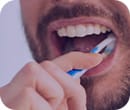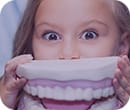General Dentistry
Periodontal disease is inflammation and infection of the tissue that supports your teeth.
Gum disease is fairly common and can be treated or managed with proper treatment.
When you come in for your dental check-up, you will be given an oral examination and then a cleaning. Here are a few things you can expect on your dental visit that keep your teeth healthy.
Taking care of your teeth in-between visits is very important to your oral health. Here are some brushing and flossing tips to keep your teeth and gums healthy.
Common Questions Or Issues
What you eat affects the air you exhale. Certain foods, such as garlic and onions, contribute to objectionable breath odor. Once the food is absorbed into the bloodstream, it is transferred to the lungs, where it is expelled. The odors will continue until the body eliminates the food. People who diet may develop unpleasant breath from infrequent eating. If you don't brush and floss daily, particles of food remain in the mouth, collecting bacteria, which can cause bad breath. Food that collects between the teeth, on the tongue and around the gums can rot, leaving an unpleasant odor.
Dry mouth occurs when the flow of saliva decreases. Saliva is necessary to cleanse the mouth and remove particles that may cause odor. Dry mouth may be caused by various medications, salivary gland problems or continuously breathing through the mouth.
Tobacco products cause bad breath, so if you use tobacco, ask your dentist for tips on kicking the habit. Bad breath may also be the sign of a medical disorder, such as a local infection in the respiratory tract, chronic sinusitis, postnasal drip, chronic bronchitis, diabetes, gastrointestinal disturbance, liver or kidney ailment.
Bruxism, commonly known as "tooth grinding," is the process of clenching together and the grinding of the upper and lower teeth. During sleep, the biting force of clenched jaws can be up to six times greater than during waking hours.
Bruxism can cause complications over the years:
- Wear down tooth enamel
- Break fillings or other dental work
- Worsening of TMJ dysfunction
- Create jaw pain, toothaches, headaches, or earaches
- Cause tooth sensitivity
- Increase tooth mobility
- Can Chip Teeth
There is no cure for bruxism; however, the condition can be managed. The most common procedure to help to alleviate pain and discomfort is a Nightguard
Oral piercings can be bad for your health. Because your mouth contains millions of bacteria, infection is a common complication of oral piercing. Pain and swelling are other side effects of piercing. Your tongue (a popular piercing site in the mouth) could swell large enough to close off your airway. Piercings can also cause uncontrollable bleeding or nerve damage. The jewelry itself also presents some hazards. You can choke on any studs, barbells or hoops that come loose in your mouth, and contact with the jewelry can chip or crack your teeth.
You are probably familiar with the links between tobacco use and lung disease, cancer and cardiovascular disease.
Current studies have also established that tobacco smoking not only causes direct damage to your mouth but also makes periodontal disease more damaging and harder to treat.
There is a greater incidence of calculus formation on teeth, deeper pockets between gums and teeth, more gum recession and more loss of the bone that hold the teeth in your mouth. In addition, smokeless tobacco greatly increases your chance of developing oral cancer. Any tobacco usage can complicate the placement of dental implants. Using smokeless (chewing) tobacco will cause tooth and gum decay which leads to tooth loss, bad breath, stain your teeth, and decrease your sense of taste and smell.
Chemicals in tobacco such as nicotine, which constricts blood vessels, slow down wound healing.
Other chemicals impair the function of your white blood cells which are your first line of defense against infection. The tars contain carcinogens which over time induce cell mutations and cancers.
Quitting tobacco use will lower the risk of your developing cancer and improve the health of your teeth and gums, as well as your heart and lungs.
Floss is cheap, so don't be stingy! Tear off about a forearm's length to start. Wrap one end around the middle finger of one hand to "anchor" it and pick up the other end about 4-6 inches away with the middle finger of the other hand. This allows you to manipulate the floss with your thumb and fore finger. As you soil a section of floss, "reel" in another 4-6 inches of clean floss with the anchor finger as you release the floss with the other finger.
Once you get the floss past the tooth contact, move the floss up and down, perpendicular to the tooth. Never shoe-shine the teeth in a back-and-forth motion! You will either notch your teeth or cut your gums, or both!
Cavities generally develop in the "hard-to-see" places in your mouth. These are normally the places where you need to floss. When bacteria combine with food particles, they form plaque that adheres to your teeth. As long as plaque remains on the tooth, acid produced by bacteria will eat away the tooth structure. Once through the enamel, the acid attacks the dentin, which is that part of the tooth containing sensitive nerve fibers.
If the tooth decay reaches the dentin, a filling is needed to halt the degenerative process. Otherwise, it continues at an accelerated rate becoming larger and larger. If not detected and repaired with a filling, the decay can reach the tooth nerve and cause the need for a root canal. With the decay removed and a filling in place the tooth is restored to its original contour.
Tooth decay happens when plaque or bacteria come in contact with the tooth and is allowed to sit. The bacteria, once fed with sugars, will begin eroding the enamel. Causes of tooth decay can include poor oral hygiene, poor diet, stress, and smoking.
Adults tend to get cavities around old fillings, which may be cracked, rough around the edges or loose in the tooth. Another common form of tooth decay in adults is root cavities. These are likely to occur in adults who have receding gums due to age or periodontal disease. As the gum line recedes, the tooth root becomes exposed. Since root tissue is softer than enamel, it decays more easily.
Schedule An Appointment
Fill out our online form to request an appointment date and time.
Schedule Appointment

